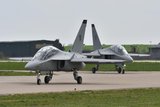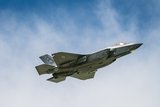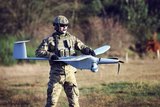Lockheed Martin awarded $118 million contract to provide Sniper Advanced Targeting Pods and LANTIRN ER navigation pods to Turkish Air Force
Lockheed Martin has signed a foreign military sales contract to deliver Sniper Advanced Targeting Pods (ATPs) and LANTIRN Enhanced Resolution (ER) navigation pods to the Turkish Air Force. Valued at $118 million, the contract will provide Sniper ATP and LANTIRN ER navigation pods to equip Turkish Air Force F-16 Block 40 and Block 50 Peace Onyx aircraft.
Sniper ATPs and LANTIRN ER navigation pods will provide a significant capability upgrade to the Turkish Air Force's F-16 fleet, said Rich Lovette, program director for Fixed-Wing Fire Control at Lockheed Martin Missiles and Fire Control. LANTIRN ER's 3rd generation navigation FLIR and enhanced image processing will allow aircrews to go far beyond their current capability. The Sniper ATP will provide enhanced target detection and identification capability, expanding the F-16's ability to conduct non-traditional intelligence, surveillance and reconnaissance operations.
Packaged in a single lightweight pod, the Sniper ATP provides critical long-range, positive identification of both moving and stationary air and ground targets. It also possesses a video downlink equipped with the widely used Rover ground receiver to relay high-resolution streaming video to forward-deployed forces for non-traditional intelligence, surveillance and reconnaissance and rapid target coordination.
Designed, developed and manufactured by Lockheed Martin, the Sniper ATP provides unrivaled precision engagement through its high-resolution, mid-wave forward-looking infrared (FLIR) and TV sensors, which operate in conjunction with a dual-mode laser, permitting eye-safe operation and precise geolocation in urban environments.
Combat proven on the F-16, F-15E, B-1, A-10 and Harrier GR7 and GR9 aircraft, the Sniper ATP is also flying on the F/A-18 and B-52. With advanced integration across US Air Force and multinational aircraft, the Sniper ATP's common software and hardware interface design enables users to plug and play across services and multiple platforms, providing a common software and hardware configuration across aircraft fleets for greater interoperability.
LANTIRN ER navigation pod, an upgraded version of the highly successful LANTIRN navigation pod, delivers multi-mission success with a significantly reduced cost of ownership. Featuring terrain-following radar, a 3rd generation mid-wave FLIR, enhanced image signal processing and increased image quality, the LANTIRN ER navigation pod allows aircrews to operate worldwide, in daylight or darkness, at mission altitudes from sea level to 40,000 feet.
Source: Lockheed Martin
More from Digital Battlespace
-
![Babcock nears first customer for Nomad AI translation tool]()
Babcock nears first customer for Nomad AI translation tool
Nomad can provide militaries with real-time intelligence, saving critical time on the battlefield.
-
![AUSA 2025: Israel’s Asio Technologies to supply hundreds of improved Taurus tactical systems]()
AUSA 2025: Israel’s Asio Technologies to supply hundreds of improved Taurus tactical systems
Taurus operates alongside the Israel Defense Forces’ Orion system which supports mission management across tens of thousands of manoeuvring forces, from squad leaders to battalion commanders.
-
![AUSA 2025: Kopin pushes micro-LED plans as China moves faster]()
AUSA 2025: Kopin pushes micro-LED plans as China moves faster
The plan for the new displays follows fresh investment in Kopin’s European facilities by Theon and an order for head-up displays in fielded aircraft, with funding from the US Department of Defense.
-
![AUSA 2025: Persistent Systems to complete its largest order by year’s end]()
AUSA 2025: Persistent Systems to complete its largest order by year’s end
Persistent Systems received its largest ever single order for its MPU5 devices and other systems earlier this month and has already delivered the 50 units to the US Army’s 4th Infantry Division.
-
![Aselsan brings in dozens of companies and systems under the Steel Dome umbrella]()
Aselsan brings in dozens of companies and systems under the Steel Dome umbrella
Turkey has joined the family of countries attempting to establish a multilayered air defence system with government approval in August 2024 for the effort landed by Aselsan. Dubbed Steel Dome, the programme joins Israel’s Iron Dome, the US Golden Dome, India’s Mission Sudarshan Chakra and South Korea’s low-altitude missile defence system.
-
![DSEI 2025: MARSS unveils new agnostic multidomain C4 system]()
DSEI 2025: MARSS unveils new agnostic multidomain C4 system
MARSS’ NiDAR system has been deployed using sensors from static platforms to provide detection and protection for static sights, such as critical infrastructure, ports and military bases.




























